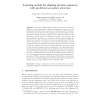820 search results - page 5 / 164 » Using Multiple Alignments to Improve Gene Prediction |
CIKM
2009
Springer
14 years 1 months ago
2009
Springer
Background: Although both conservation and correlated mutation (CM) are important information reflecting the different sorts of context in multiple sequence alignment, most of ali...
RECOMB
2009
Springer
14 years 8 months ago
2009
Springer
Accurately aligning distant protein sequences is notoriously difficult. A recent approach to improving alignment accuracy is to use additional information such as predicted seconda...
EVOW
2010
Springer
13 years 10 months ago
2010
Springer
A challenging problem in bioinformatics is the detection of residues that account for protein function specificity, not only in order to gain deeper insight in the nature of functi...
BMCBI
2006
13 years 7 months ago
2006
Background: In order to improve gene prediction, extrinsic evidence on the gene structure can be collected from various sources of information such as genome-genome comparisons an...
NAR
2006
13 years 7 months ago
2006
HHsenser is the first server to offer exhaustive intermediate profile searches, which it combines with pairwise comparison of hidden Markov models. Starting from a single protein ...

